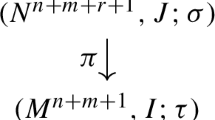Abstract
Consider the controlled system dx/dt = Ax + α(t)Bu where the pair (A, B) is stabilizable and α(t) takes values in [0, 1] and is persistently exciting, i.e., there exist two positive constants μ, T such that, for every t ≥ 0, \({\int_t^{t+T}\alpha(s){\rm d}s \geq \mu}\). In particular, when α(t) becomes zero the system dynamics switches to an uncontrollable system. In this paper, we address the following question: is it possible to find a linear time-invariant state-feedback u = Kx, with K only depending on (A, B) and possibly on μ, T, which globally asymptotically stabilizes the system? We give a positive answer to this question for two cases: when A is neutrally stable and when the system is the double integrator.
Similar content being viewed by others
References
Aeyels D, Peuteman J (1998) A new asymptotic stability criterion for nonlinear time-variant differential equations. IEEE Trans Automat Control 43: 968–971
Aeyels D, Peuteman J (1999) On exponential stability of nonlinear time-varying differential equations. Automatica J IFAC 35: 1091–1100
Aeyels D, Sepulchre R (1994) On the convergence of a time-variant linear differential equation arising in identification. Kybernetika 30: 715–723
Anderson BDO (1977) Exponential stability of linear equations arising in adaptive identification. IEEE Trans Automat Control 22: 83–88
Boscain U (2002) Stability of planar switched systems: the linear single input case. SIAM J Control Optim 41: 89–112
Branicky MS (1998) Multiple Lyapunov functions and other analysis tools for switched and hybrid systems. IEEE Trans Automat Control 43: 475–482
Brezis H (1983) Analyse fonctionnelle, Théorie et applications. Collection Mathématiques Appliquées pour la Maîtrise, Masson
Colaneri P, Geromel JC, Astolfi A (2005) Stabilization of continuous-time nonlinear switched systems. In: Proc 44th IEEE conf decision contr (Sevilla, Spain)
Gihman II (1952) Concerning a theorem of N. N. Bogolyubov (Russian). Ukrain Mat Ž 4: 215–219
Liberzon D (2003) Switching in systems and control. Systems and control: foundations and applications. Birkhäuser, Boston
Liu W, Sussmann HJ (1999) Continuous dependence with respect to the input of trajectories of control-affine systems. SIAM J Control Optim 37: 777–803
Loría A, Chaillet A, Besancon G, Chitour Y (2005) On the PE stabilization of time-varying systems: open questions and preliminary answers. In: Proc 44th IEEE conf decision contr (Sevilla, Spain), pp 6847–6852
Morgan AP, Narendra KS (1977) On the stability of nonautonomous differential equations \({\dot{x} = [A + B(t)]x}\) with skew-symmetric matrix B(t). SIAM J Control Optim 15: 163–176
Segal IE, Kunze RA (1978) Integrals and operators. Springer, Berlin
Shorten R, Wirth F, Mason O, Wulff K, King C (2007) Stability criteria for switched and hybrid systems. SIAM Revi (to appear)
Sontag E (1998) Mathematical control theory: deterministic finite dimensional systems. Springer, New York
Teel AR, Peuteman J, Aeyels D (1999) Semi-global practical stability and averaging. Systems Control Lett 37: 329–334
Author information
Authors and Affiliations
Corresponding author
Additional information
Notation
A continuous function \({\phi : \mathbb{R}_{\geq 0} \to \mathbb{R}_{\geq 0}}\) is of class \({\mathcal{K}\, (\phi \in \mathcal{K})}\), if it is strictly increasing and \({\phi(0) = 0.\, \psi : \mathbb{R}_{\geq 0} \to \mathbb{R}_{\geq 0}}\) is of class \({\mathcal{L}\, (\psi \in \mathcal{L})}\) if it is continuous, non-increasing and tends to zero as its argument tends to infinity. A function \({\beta : \mathbb{R}_{\geq 0} \times \mathbb{R}_{\geq 0} \to \mathbb{R}_{\geq 0}}\) is said to be a class \({\mathcal{KL}}\)-function if, \({\beta(\cdot,t) \in \mathcal{K}}\) for any t ≥ 0, and \({\beta(s, \cdot) \in \mathcal{L}}\) for any s ≥ 0. We use |·| for the Euclidean norm of vectors and the induced L 2-norm of matrices.
Rights and permissions
About this article
Cite this article
Chaillet, A., Chitour, Y., Loría, A. et al. Uniform stabilization for linear systems with persistency of excitation: the neutrally stable and the double integrator cases. Math. Control Signals Syst. 20, 135–156 (2008). https://doi.org/10.1007/s00498-008-0024-1
Received:
Accepted:
Published:
Issue Date:
DOI: https://doi.org/10.1007/s00498-008-0024-1




